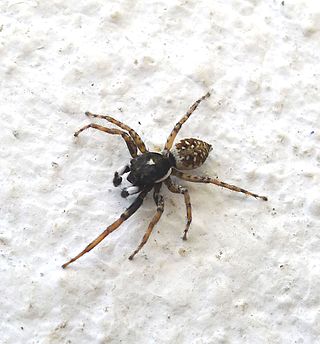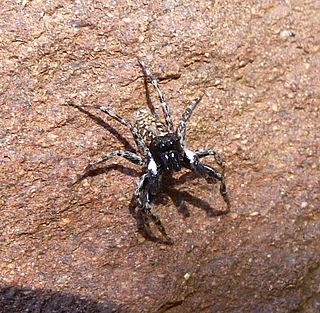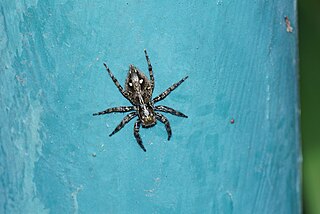Mogrus cognatus is a species of jumping spider in the genus Mogrus that lives in United Arab Emirates and Yemen. The spider was first defined in 1994 by Wanda Wesołowska and Anthony Van Harten. It is a small spider. The male has a dark brown or fawn-brownish carapace that range between 2.6 and 2.8 mm long and a yellow-white or dark brown abdomen between 2.7 and 3.1 mm long. The female has not been described. The spider is similar to the related Mogrus fulvovittatus, but can be distinguished by its copulatory organs. It has a long thin embolus that encircles the palpal bulb and has a distinctive membane at its base.
Mogrus portentosus is a species of jumping spider in the genus Mogrus that is endemic to Yemen. The spider was first described in 1994 by Wanda Wesołowska and Antonius van Harten. It is brown with a carapace that is between 2.3 and 2.7 mm and an abdomen that is between 2.3 and 3.5 mm long. The female is larger than the male. The spider resembles the related Mogrus fulvovittatus, particularly the female, which can only be clearly differentiated by looking the internal structure of its epigyne. The male is also distinguished by its copulatory organs. It has a distinctive loop on the end of its embolus and a bulbous base to its single tibial apophysis, or spike.

Menemerus davidi is a species of jumping spider in the genus Menemerus that lives in North Africa and the Middle East. The species was first identified in 1999 by Jerzy Prószyński and Wanda Wesołowska working initially independently, and then together. The first description was published by Wesołowska, one of over 500 descriptions she produced during her lifetime. The spider is small, with a carapace that ranges between 2.3 and 3.0 millimetres long and an abdomen that is 2.2 and 3.2 millimetres long, although the female is larger than the male. The carapace is generally a uniform dark brown while the abdomen has a pattern of a light brown stripe and white patches that serves to distinguish it from the related Menemerus animatus. Otherwise, it is its copulatory organs that most distinguish the species from others in the genus. It has distinctive internal structure to the female epigyne. The wide copulatory openings lead down the centre of the spider to the spermathecae while there is also a short narrower channel that runs to the rear of the spider with a prominent scent pore at the end. The male has a noticeably smaller embolus and a distinctive dorsal tibial apophysis.

Menemerus minshullae is a species of jumping spider in the genus Menemerus that lives in South Africa, Malawi and Zimbabwe. The species was first described in 1999 by Wanda Wesołowska, one of over 500 descriptions she has completed during her lifetime. She originally identified the male as a different species, named Menemerus manicus, but merged the two in 2007. It is small to medium-sized spider with a cephalothorax that is between 1.9 and 2.2 millimetres long and an abdomen between 2.1 and 3.3 millimetres long. The female is larger than the male and lighter, with a dark brown rather than black carapace and lighter brown abdomen. The abdomen has a large, leaf-shaped, pattern. It lives on Vachellia xanthophloea trees, using its flattened shape to hide under flakes of bark. The copulatory organs distinguish the species from others in the genus. The male has a very short embolus with a larger accompanying conductor. The female epigyne has two pockets that have strongly sclerotized edges.

Menemerus zimbabwensis is a species of jumping spider in the genus Menemerus that lives in South Africa and Zimbabwe. The Polish arachnologist Wanda Wesołowska first described the female in 1999 and the male in 2007. The spider is large, with a cephalothorax that is between 1.9 and 3.2 millimetres long and an abdomen that is between 2.1 and 4.6 millimetres in length. The female is larger than the male. It also lacks the light stripe down the centre of its dark brown carapace and has a less distinct pattern on its abdomen. Its legs and pedipalps are yellow, while on the male they are brown. The male can be distinguished from the similar Menemerus nigli by the wide stripe on its abdomen. The female is harder to identify without looking at its copulatory organs. These are distinctive. It has characteristic large entrance bowls on its epigyne, which are larger than the insemination ducts and spermathecae combined. Its internal organs are very sclerotized.

Hasarius insularis is a species of jumping spider in the genus Hasarius that lives on Socotra Island, Yemen. It was first described in 2002 by Wanda Wesołowska and Antonius van Harten. The spider is medium-sized, with a carapace that measures typically 4.5 mm (0.18 in) in length and an abdomen that is typically 5.9 mm (0.23 in) long. It has a cephalothorax that is mainly reddish-brown on top and yellowish on the bottom. The abdomen has dark topsides with a yellowish pattern and dark dots and patches underneath. It has copulatory organs that are similar to other species in the genus. The insemination ducts are relatively short and the spermathecae spherical, but they are both thicker than those found in other examples. The spider's name recalls a Latin word that means "insular".

Pellenes striolatus is a species of jumping spider in the genus Pellenes that lives on Socotra Island, Yemen. It was first described in 2002 by Wanda Wesołowska and Antonius van Harten. The spider is smaller than many in the genus, with a carapace that measures typically 1.4 mm (0.06 in) in length and an abdomen that is between 1.3 and 2 mm long. The female has a larger abdomen than the male. Both are generally very dark, nearly black, and have a distinctive white pattern on the abdomen. The pattern consists of a central white stripe that is flanked by white diagonal lines, and is recalled in the species name, which can be translated "thinly streaked". The spider has copulatory organs that are similar to other species in the genus. The female has a shallow pocket in the middle of its epigyne and the male has a thick embolus.

Pseudomogrus logunovi is a species of jumping spider in the genus Pseudomogrus that lives in United Arab Emirates. The species was first defined by Wanda Wesołowska and Antonius van Harten in 2010. They originally placed it in the genus Yllenus, but it was moved to the new genus Logunyllus in 2016, and then to its present designation in 2019. The spider is small, with a cephalothorax that is between 1.5 and 2.0 mm long and an abdomen between 1.6 and 2.2 mm long. The female is larger than the male. The female can be distinguished by its plain brown carapace, in comparison with the male that has two white stripes on its darker surface. Both have brown patches on their yellow legs. The spider can be identified by its copulatory organs. The male has a straight spike on the tibia of its pedipalps, or tibial apophysis, a long embolus with a narrow accompanying terminal apophysis and a small tegulum. The female is hard to distinguish but has shorter insemination ducts than related species.

Evarcha arabica is a species of jumping spider in the genus Evarcha that lives in Yemen. The species was first described in 2007 by Wanda Wesołowska and Antonius van Harten. The spider is small, with a carapace that measures between 2.1 and 2.7 mm long and an abdomen that is between 1.8 and 3.2 mm long. The female is generally larger and lighter than the male. The spider's eye field is darker. The top of the male abdomen is blackish-brown with a pattern of white dots and a large yellowish-orange belt. The top of the female abdomen has similar white dots but is mainly yellow with small darker dots. The male's legs are brown and yellow while the female's are orange to yellow. It has distinctive copulatory organs. The female has accessory glands near the copulatory openings and simple bean-like spermathecae. The male has a thin embolus and a tibial apophysis that has a forked tip.

Evarcha picta is a species of jumping spider in the genus Evarcha that lives in Yemen. The species was first described in 2007 by Wanda Wesołowska and Antonius van Harten. The spider is small, with a carapace that measures between 2.4 and 2.6 mm long and an abdomen that is between 2 and 2.4 mm long. It has a distinctive pattern on its abdomen that is recalled in its name, which can be translated "patterned", which includes a series of white dots and chevrons. The pattern is less clear on the female than the male. Otherwise, the spider is generally brown and yellow. The male's legs are brown and yellow while the female's are yellow. There is a characteristic fovea, or indentation, in the centre of the carapace. It has distinctive copulatory organs. The female has a large depression in the centre of its epigyne and narrow insemination ducts that lead to long accessory glands and small spermathecae. The male has a terminal apophysis that makes it look as if its embolus has two branches. The spider's brownish-orange clypeus is also an identifying trait.

Evarcha seyun is a species of jumping spider in the genus Evarcha that is endemic to the Arabian peninsula. It seems to be common across many of the Emirates of the United Arab Emirates and the Al Mahrah and Hadramaut Governorates of Yemen. The species was first described in 2007 by Wanda Wesołowska and Antonius van Harten. The spider is small, with a cephalothorax that measures between 2.2 and 2.6 mm long and an abdomen that is between 2 and 2.7 mm long. The female is hairier than the male. The female spider is generally brown with a darker eye field, while the male is dark brown with a black eye field. Both have legs that are black, orange and yellow. They can be distinguished from the closely-related Evarcha praeclara by the patterns on their body, including a semi-lunar marking in the middle of its carapace and a light stripe on its abdomen. The species also has distinctive copulatory organs. The female has a characteristic depression in the middle of its epigyne and narrow insemination ducts that lead to complex spermathecae. The male has a spade-like apophysis that accompanies its embolus and a short blunt tibial apophysis.

Menemerus pallescens is a species of jumping spider in the genus Menemerus that lives in Yemen. The spider was first described in 2007 by Wanda Wesołowska and Antonius van Harten. Other examples have been found in the Emirate of Dubai. The spider is medium sized with a carapace that is between 2.5 and 3.1 mm long and abdomen between 3.4 and 4.2 mm long. The carapace is dark brown with white stripes at the back. The abdomen is yellowish-beige or light grey, sometimes with a pattern of lines and spots. The legs are yellow. The spider is hard to distinguish from others in the genus without a study of its copulatory organs. The spider has a shallow notch at rearmost edge of its epigyne and long accessory glands. The male has not been described.

Menemerus patellaris is a species of jumping spider in the genus Menemerus that lives in Yemen. The spider was first described in 2007 by Wanda Wesołowska and Antonius van Harten. The spider is medium sized with a carapace that is typically 2.6 mm (0.10 in) long and abdomen between 2.9 mm (0.11 in) long. The carapace is brown with white stripes on the edges. The abdomen is yellowish-beige, while the legs are yellow. The spider is hard to distinguish from others in the genus without a study of its copulatory organs. It has a very short embolus and a distinctive furrow in its tegulum dividing a sac of tissue used in copulation called the haematodocha. In addition to the spike, or apophysis on its tibia, it has another one on the patellar, the section between the tibia and the palpal bulb.

Euophrys kawkaban is a species of jumping spider in the genus Euophrys that is endemic to Yemen. The species was first described in 2007 by Wanda Wesołowska and Antonius van Harten. It is a very small spider, with a body that consists of a carapace, the hard upper part of the cephalothorax, that is typically 1.7 mm (0.07 in) long and 1.3 mm (0.05 in) wide and an abdomen that is typically 1.5 mm (0.06 in) long and 1.1 mm (0.04 in) wide. The carapace is yellowish, marked with a pattern of brown wedges, with a dark brown eye field. The underside of the cephalothorax, or sternum, is yellowish-brown. The abdomen has a pattern of yellowish-white and brownish-black spots that, at times, look like a series of waves. The spider's clypeus is unusual, being yellowish-brown with a covering of white hairs, which clearly differentiates the species from the related Euophrys flavoater. The male's copulatory organs, including its long and thin embolus, also helps distinguish the species. The female has not been described.

Aelurillus desertus is a species of jumping spider in the genus Aelurillus that is endemic to the United Arab Emirates. It was first described in 2010 by Wanda Wesołowska and Antonius van Harten. Initially only the male was described, the female following ten years later. The spider was originally classified in the genus Rafalus but was moved to its current genus at the same time as the female description was first published. The species is medium-sized with cephalothorax that is between 2.8 and 3.3 mm long and a abdomen that is between 2.8 and 4.8 mm long. The female is larger than the male. The carapace has a distinctive stripe. The female has three darker spots on the abdomen. The species can be distinguished by the existence of a triangular lobe on the palpal bulb on the male and the way that the copulatory openings are close to the rear of the epigyne on the female.

Menemerus cummingorum is a species of jumping spider in the genus Menemerus that lives in Zimbabwe. The species was first described in 2007 by Wanda Wesołowska, one of over 500 descriptions she has written during her lifetime. It is medium-sized spider, with a flattened cephalothorax that is between 2.2 and 2.4 mm and an oval abdomen between 2.3 and 2.9 mm long. The female has a larger abdomen than the male. It is also dark brown and marked with a large yellow leaf-shaped pattern compared to the yellowish-grey of the male. Both the male and female have a dark brown carapace, with a pattern of white streaks, a line and five patches, although the pattern is more pronounced on the male. It has yellow legs, the foremost pair being darker and having brown patches. It is similar to the related Menemerus minshullae, but larger.

Menemerus paradoxus is a species of jumping spider in the genus Menemerus that lives in Yemen. The spider was first described in 1994 by Wanda Wesołowska and Anthony van Harten. Only the female has been described. The spider is small, with an oval and rather flattened carapace that is typically 2.5 mm (0.10 in) long and an oval abdomen typically 3.2 mm (0.13 in) long. The carapace is brown with a darker, nearly black, eye field and the abdomen is yellowish-grey. The spider's legs are also yellowish-grey. The spider is hard to distinguish from others in the genus, particularly Menemerus tropicus. However, its copulatory organs are distinctive. Menemerus paradoxus is characterised by its large epigyne that has a notch in its rear edge, the way that its copulatory openings are hidden in pockets and its heavily sclerotized spermathecae.

Menemerus plenus is a species of jumping spider in the genus Menemerus that lives in Yemen. The spider was first described in 1994 by Wanda Wesołowska and Anthony van Harten. Only the female has been described. The spider is small, with a carapace that is typically 2.0 mm (0.08 in) long and an abdomen typically 3.3 mm (0.13 in) long. The carapace is brown, convex and higher than many related spiders. The abdomen is wide and rounded. It is externally similar to Menemerus pulcher and can only be reliably distinguished by comparing the internal structure of the copulatory organs. Menemerus plenus is distinctive for its lack of accessory glands and the thick wall of its insemination ducts.

Plexippus minor is a species of jumping spider in the genus Plexippus that lives in the United Arab Emirates. The male was first described by Wanda Wesołowska and Antonius van Harten in 2010 and the female in 2020. The spider is medium-sized with a cephalothorax between 3.1 and 3.8 mm long and an abdomen between 3.3 and 4.1 mm long. It has a shape and colouring typical of the genus. The male has a orange carapace while the female is brownish-fawn. The copulatory organs distinguish it from related species, particularly the male's shorter embolus and tibial apophysis and the female's wide pocket on its epigyne.

Chalcoscirtus picinus is a species of jumping spider in the genus Chalcoscirtus that has been only found in the United Arab Emirates. The spider was first described in 2011 by Wanda Wesołowska and Antonius van Harten. It is a small spider, with a cephalothorax typically 1.4 mm (0.06 in) long and an abdomen typically 2 mm (0.08 in) long. It is hard to tell externally from other spiders as it is similar in size to others in the genus and, like many others, lacks a distinctive pattern on its body. Its carapace is generally greyish-brown with a black eye field while its abdomen is blackish-grey. The spider's copulatory organs. are its most distinguishing feature. The female has a small window made of membrane in the middle of its epigyne, which is narrower than that found in other species in the genus. The male has not been described.
















